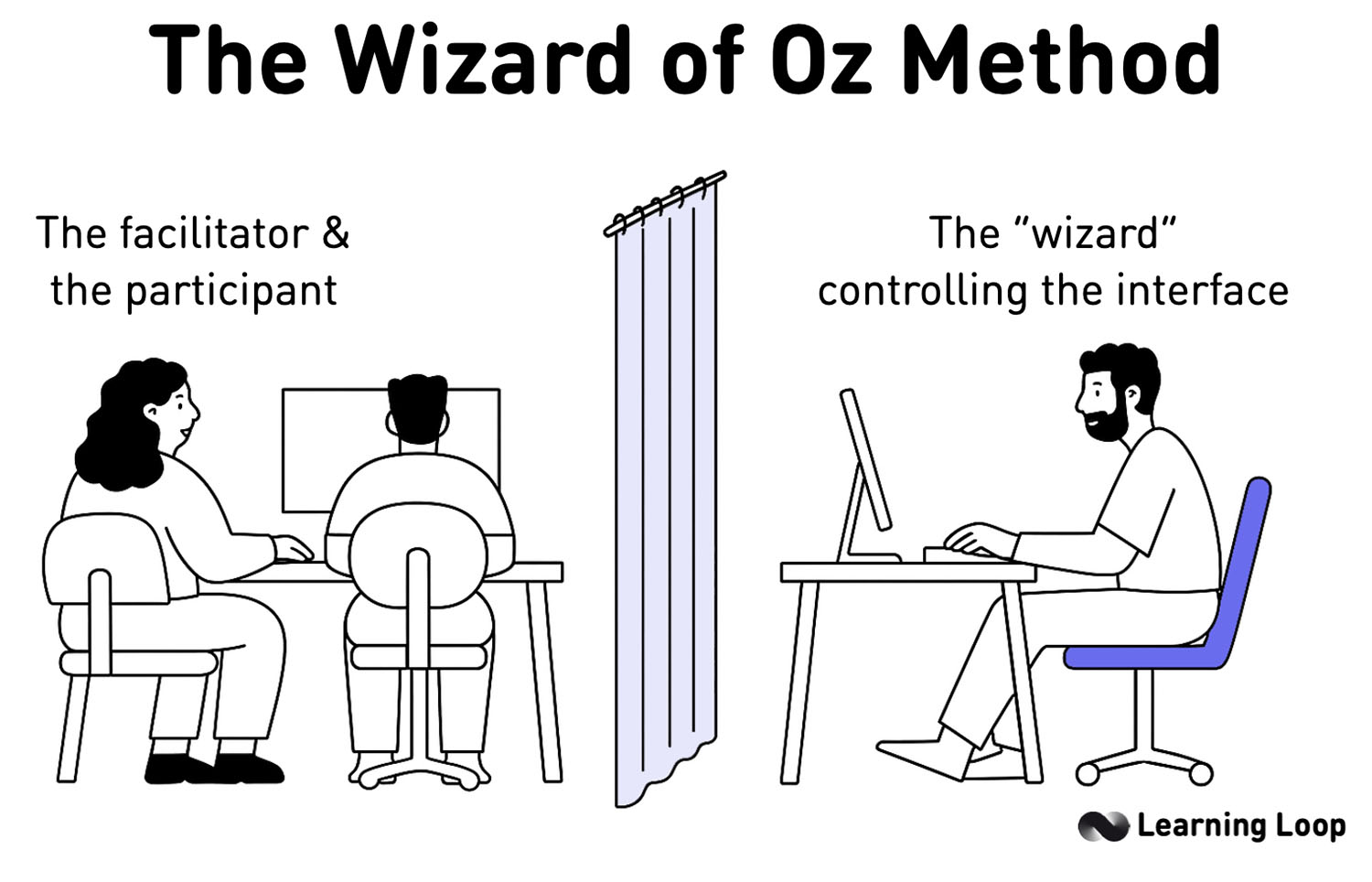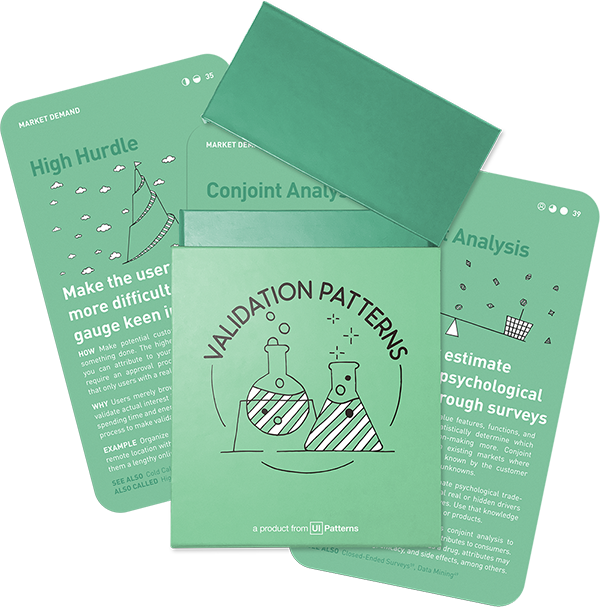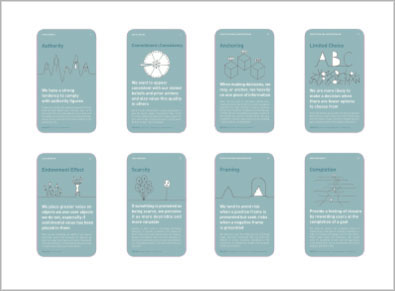Idea Validation: Market demand, Product
Wizard of Oz
Use human power to fake automation of complex tasks

How: Use your own hands, an intern, or online crowdsourcing services to fake automation of tasks that are now too costly to build. To keep the facade of no human involvement, consider constructing your experiment so that real-time response is not needed in order to deliver on the value proposition you're testing.
Why: Humans can be cheaper than automation. Even if this takes longer for the customer to receive an answer, you will avoid wasting precious time building features the customer does not want.
A Wizard of Oz experiment is a user research method where participants believe they are interacting with an automated system, but it is actually operated by a human behind the scenes.
A Wizard of Oz technique allows for early testing of system behavior, particularly when development is costly, technology is immature, or user behavior is uncertain. It is widely used in fields like UX design, HCI, and AI prototyping to validate ideas and gather real user feedback without building a fully functional product.
Wizard of Oz testing involves several stages, including defining the test goal and user tasks, designing a realistic but minimal prototype, configuring a human operator to simulate system responses, running test sessions with users unaware of the human element, and collecting and analyzing behavioral and verbal feedback for iterative design improvement.
Notable examples of Wizard of Oz prototyping include Zappos, where the founder manually fulfilled shoe orders to test e-commerce viability. Aardvark simulated an automated Q&A service with human-managed question routing. Speech recognition studies conducted by IBM and others, in which human typists simulated real-time voice input systems.
Key benefits of the Wizard of Oz method include low development cost, rapid validation of ideas, and the ability to gather authentic user feedback in a realistic context. However, limitations and challenges include issues with scalability, operator consistency, and potential ethical concerns due to user deception, making careful planning and transparent post-session debriefing essential.
What is a Wizard of Oz Experiment?
A Wizard of Oz experiment is a user research method where participants interact with a system they believe to be autonomous, but which is actually operated by a human behind the scenes. A Wizard of Oz technique allows researchers to test and simulate system behavior before building full functionality.

The term “Wizard of Oz” originated from the 1939 film The Wizard of Oz, where a powerful “wizard” is revealed to be a man hidden behind a curtain manipulating events. In a similar way, the human operator in the experiment stays out of view, mimicking how a real system might respond to users.
The core principle behind a Wizard of Oz experiment is deception by design — participants think they are engaging with a finished product, but the responses or behaviors are controlled manually. This enables teams to observe natural user interactions and expectations without committing to high development costs.
Wizard of Oz testing is widely used in human-computer interaction (HCI), UX design, AI prototyping, and voice interface design. It helps test feasibility, gather early feedback, and validate ideas quickly.
Researchers and developers use the Wizard of Oz method when the cost of full development is high, the user behavior is uncertain, or the technology is not yet fully developed. It is particularly effective in the early stages of design when exploring novel interfaces or unproven interaction models.
Unlike traditional user testing, which evaluates fully built systems, Wizard of Oz experiments simulate the experience to gather insights before the product exists. This method reduces risk and reveals critical design or usability issues early in the process.
What is a Wizard of Oz Prototype?
A Wizard of Oz prototype is a low-fidelity simulation of a product or system, where a human manually performs the functions that users believe are automated. A Wizard of Oz prototype serves as a core instrument within the broader Wizard of Oz experiment methodology.
The prototype enables testing of user interactions, workflows, and expectations before building any real technology. Designers use it to simulate system responses and gather actionable feedback without committing to full development.
Defining characteristics of the Wizard of Oz prototype include the following.
- Human-operated system behaviors are concealed from users.
- Low technical implementation with scripted or reactive inputs.
- Focused on user perception, not backend performance.
- Iterative structure, easily changed based on feedback.
Wizard of Oz prototypes allow teams to test AI interactions, chatbots, voice interfaces, or new UX flows where outcomes are uncertain. These prototypes reduce time and risk by validating assumptions early, ensuring user needs are met before investing in engineering.
How Does Wizard of Oz Testing Work?
The list below explains how Wizard of Oz Testing works.
- Planning & Design. Wizard of Oz testing starts by defining the interaction flow to test including its users and desired goal state. Teams identify which system behaviors will be faked and what user tasks will be observed.
- Setup the prototype. A simple interface is created to mimic the real product. It may use wireframes, clickable mockups, or scripted dialogs. The prototype needs to appear real to the user but remains technically minimal.
- Operator Configuration. A human operator is trained to simulate system responses. It could be changing things on the screen, writing back an email, or in any way providing the expected response. The operator follows predefined logic or improvises within structured boundaries to maintain realism.
- User Testing Execution. Participants interact with the prototype under the belief it’s autonomous. Sessions can be remote or in person. The operator responds in real time to user inputs, maintaining the illusion of automation.
- Observation & Data Collection. Researchers record user actions, decisions, and verbal feedback. Observers note breakdowns, expectations, and satisfaction levels to understand user behavior.
- Analysis & Iteration. Collected data informs design improvements. Teams revise prototypes, update scripts, or redefine features. Iterative cycles refine the solution before development investment.
A key benefit of Wizard of Oz testing is the ability to improvise mid-way, mimicking advanced computational responses that would be costly to implement. This tailoring of responses allows for testing out many variations of what will help the user succed.
Wizard of Oz testing is a fast and effective way to test your hypothesis as to whether your proposed solution will in fact create value for your potential customers. At the same time, performing all tasks manually comes with the added benefit of being easily adjustable. Being able to quickly modify your hand-held product experience lets you test a larger number of hypotheses, quickly – finding the most effective solution, fast.
When to Use Wizard of Oz Experiment Design?
Wizard of Oz experiment design is most beneficial during early product exploration when ideas need testing without full technical investment. It helps validate user demand, usability, and system expectations before development begins.
Why would you do this?
First, a Wizard of Oz prototype provides a unique opportunity to verify the demand of your product that, so far, only exists in your mind. So why spend time and money building an elaborate system to handle and automate your customers’ requests, when you can just test whether anybody are interested at all in your future product, by hand-holding the entire process yourself.
Secondly, conducting all tasks manually will provide unique insights into what it takes to deliver customer value as well as how users react when you finally deliver value to them.
Situations for when to use Wizard of Oz experiment design are listed below.
- Concept Validation: When testing whether users understand or want a proposed feature or interaction.
- High Uncertainty: When technical feasibility or user response is unknown or untested.
- Voice or AI Prototyping: When simulating natural language interfaces, chatbots, or speech recognition without actual algorithms.
- Interface Exploration: When comparing interaction models, flows, or layout options based on real-time user reactions.
- Resource Constraints: When teams lack budget, time, or engineering support to build a working version of the product.
- Behavioral Research: When observing how users naturally engage with a system before shaping rules or automation logic.
What Are Examples of Wizard of Oz Prototyping?
Examples of Wizard of Oz prototyping are listed below.
- Zappos: Zappos validated demand for online shoe sales by manually simulating a full e-commerce experience, with the founder fulfilling orders himself to test market viability before building infrastructure.
- Aardvark: Aardvark tested its peer-to-peer Q&A platform by manually routing and responding to questions in real time to simulate automated matchmaking and assess user engagement.
- Speech Recognition: Researchers validated voice interface usability by having human typists simulate real-time speech recognition, allowing observation of natural language interactions without actual voice technology.
- IBM Speech Prototype: IBM explored user acceptance of speech-driven systems by manually transcribing voice input to mimic automation, helping define expectations and design requirements for future voice products.
How Is the Wizard of Oz Experiment Used to Improve UX?
Wizard of Oz experiments improve UX by revealing how users interact with a system before it is built. This method allows teams to observe real user behavior, identify usability issues, and refine interaction models without developing backend functionality.
Key UX aspects validated include interaction flow, user intent, feature expectations, terminology clarity, and system feedback timing. These elements are critical for intuitive design and can be optimized based on direct user response during testing.
Wizard of Oz testing is useful in early design because it reduces risk and development cost. Teams test ideas quickly, gather insights, and pivot based on actual user reactions. It enables designers to make informed decisions grounded in user behavior, not assumptions.
How to Conduct a Wizard of Oz Experiment?
To conduct a Wizard of Oz experiment, follow the steps listed below.
- Plan the Test. Define the goal by asking what specific aspects of the design or concept are you testing. Then select a task that users would typically perform with the product and create a script for the “wizard” (the person controlling the interface) to follow. This script should outline how they should interact with the user and the system.
- Set Up the Test Environment. Create a Mock Interface that could be as simple as a paper mockup, a low-fidelity prototype, or even a real interface where the “wizard” controls the hidden elements. Determine how the “wizard” will communicate with the user and control the interface (e.g., using a separate computer, headphones, or direct instructions).
- Conduct the Test. Recruit participants who represent your target audience and get ready to observe. Have the “wizard” interact with the user, following the script. The observer should record user behavior, feedback, and any challenges. Collect data on user interactions, including screenshots, video recordings, and written notes.
- Analyze the Results. Analyze the collected data to identify areas where the design is unclear, confusing, or difficult to use. Analyze user feedback to understand their needs, expectations, and pain points. Use the insights gained from the test to refine the design and make improvements.
What Is a Wizard of Oz MVP?
A Wizard of Oz MVP is a Minimum Viable Product that simulates core functionality through human effort instead of actual software or automation. Users believe they are interacting with a working system, but tasks are completed manually behind the scenes.
This method combines MVP principles—delivering the smallest version of a product to test assumptions—with Wizard of Oz tactics where human operators mimic backend processes. It enables early validation without building full infrastructure.
A Wizard of Oz MVP helps startups validate business ideas, pricing models, or feature interest before scaling. It reduces development cost, shortens feedback loops, and ensures effort is only invested in concepts proven to solve real user problems.
What’s the Difference Between a Wizard of Oz MVP and a Concierge MVP?
The main difference between a Wizard of Oz MVP and a Concierge MVP is user awareness. In a Wizard of Oz MVP, users believe they are interacting with an automated system, while in a Concierge MVP, users know a human is delivering the service manually.
Wizard of Oz MVPs test product realism and automation assumptions without revealing the simulation. Concierge MVPs test value and user experience by offering high-touch, personalized service to validate demand and learning goals directly.
What Tools and Technologies Support Wizard of Oz Testing?
Listed below are tools and technologies supporting Wizard of Oz testing.
- Mechanical Turk. Amazon Mechanical Turk connects researchers with distributed workers who can simulate backend processes or respond to user inputs in real time during testing.
- MicroWorkers. MicroWorkers provides a global crowd workforce that can be instructed to act as system components, enabling scalable simulations with diverse human input.
- Figma or Adobe XD. These design tools allow creation of interactive prototypes that resemble real products. They help build believable user interfaces without functional code.
- Slack or Discord. Real-time messaging tools like Slack or Discord enable silent coordination between the operator and observer team during live tests.
- Lookback or Zoom. Lookback and Zoom support session recording, screen sharing, and user interaction observation, ensuring reliable data capture.
- Airtable or Google Sheets. These tools help structure operator scripts, track user actions, and log system responses during and after sessions.
- OBS Studio or Loom. Recording tools like OBS or Loom capture user behavior, audio, and system feedback for post-test analysis.
What Are the Benefits of the Wizard of Oz Method?
The benefits of the Wizard of Oz method are listed below.
- Low Development Cost: The method eliminates the need for backend coding during early testing, saving time and resources.
- Rapid Validation: Teams can quickly test user reactions, feature value, and design assumptions without building real functionality.
- Realistic User Feedback: Participants interact as if the system is live, producing authentic behavioral data and reactions.
- Early Usability Insights: Design flaws and user confusion are detected before technical implementation, guiding better design decisions.
- Flexible Iteration: Scripts and UI mockups are easy to adjust between tests, allowing fast adaptation to findings.
- Supports Innovation: Unproven concepts or novel interfaces can be explored safely without committing to complex development.
- Informs Prioritization: Validated insights help product teams decide which features to build first based on actual user demand.
What Are the Limitations and Challenges of the Wizard of Oz Method?
Limitations and challenges of the Wizard of Oz method are listed below.
- Scalability Issues: Manual operation cannot handle large volumes of users or complex interactions over time.
- Operator Consistency: Human operators may introduce variability, leading to inconsistent system responses and data quality.
- User Trust Risk: If users discover the simulation, it can damage credibility and affect behavior during the test.
- High Coordination Load: Real-time response simulation demands tight coordination and clear communication between team members.
- Limited Complexity: Only simple or controlled workflows can be effectively simulated, limiting the test scope for advanced logic.
- Data Interpretation Gaps: Unexpected user behavior may be hard to handle on the fly, affecting data accuracy and requiring post-hoc clarification.
- Ethical Considerations: Deception-based testing raises ethical concerns and may require special consent or post-session debriefing.
What Are the Ethical Considerations When Using the Wizard of Oz Method?
Listed below are the common ethical considerations when using the Wizard of Oz method.
- Informed Consent: Participants must be told they are part of a research study, even if full system details are withheld to preserve realism.
- Deception Disclosure: If deception is used, it should be minimal, justified by research goals, and explained during a debrief afterward.
- User Autonomy: Users should have the right to withdraw at any time without penalty or pressure, especially if deception is involved.
- Privacy and Data Use: Data collected during the session must be securely stored, anonymized, and used only for agreed research purposes.
- Emotional Impact: Simulated failures or limitations must not distress participants or create negative experiences beyond reasonable testing boundaries.
- Debriefing Obligation: After the session, participants should be clearly informed about the simulated aspects and purpose of the study.
- Ethical Review Compliance: Studies involving deception may require review by an ethics board or institutional review body, especially in academic or regulated environments.
Popular tools
The tools below will help you with the Wizard of Oz play.
-
Mechanical Turk
This Amazon service provides access to a global, on-demand 24/7 workforce conducting simple tasks called HIT – "Human Intelligence Tasks".
-
MicroWorkers
An alternative to the original Mechanical Turk service by Amazon that provide a series of ready-to-use templates.
Real life Wizard of Oz examples
Zappos
Zappos founder, Nick Swinmurn, decided to test the assumption that people would be willing to buy shoes online without trying them on. Instead of building an inventory and then trying to sell it, Nick took a different approach. He went to local stores, photographed shoes, and then advertised them online. If a pair of shoes were sold, Nick would go back to the store, buy the shoe, and send it to the customer.
From the customers perspective, it would look like Zappos had a full inventory of shoes, while in fact, all orders were processed in this unscalable way manually. Nick could use this experiment to fine tune marketing, wording, packeting, and product categories in terms of what constituted better product/market fit. Once momentum was gained, Zappos could push play and invest in expensive inventory and handling as the certainty of success was maximized.
Source: The Wizard of Oz MVP
Aadvark
The Q&A service, Aadvark, routes questions to expert users (via instant messaging). In the early days, the Aadvark staff would manually post the questions to whomever was online to see if that particular user would respond, and then manually post the answer back to the asker. There was no automation or algorithm. The feature was later built to automate this functionality. From the outside, this MVP looked like a fully functional system, even though most tasks were manually executed behind the scenes by a human.
Testing speech recognition
To test the usefulness of an app involving speech recognition without actually implementing speech recognition, a usability test was set up where the participant talked in a microphone and a typist listening next door made the right words appear on the participant’s screen.
IBM Speech Recognition
IBM tested market interest in speech-to-text technology by using a dummy computer and a hidden typist to simulate a functioning prototype. This experiment provided valuable insights into user acceptance and feasibility of the technology.
A collection of 60 product experiments that will validate your idea in a matter of days, not months. They are regularly used by product builders at companies like Google, Facebook, Dropbox, and Amazon.
Get your deck!Related plays
- Universal Methods of Design by Bruce Hannington & Bella Martin
- Wizard of Oz MVP by Anatoliy Yarandin
- Concierge vs. Wizard of Oz Test - what's the differency by Tristan Kromer
- The Real Startup book - Wizard of Oz by Tristan Kromer, et. al.

